Evaluation of Two Low-Cost Optical Particle Counters for the Measurement of Ambient Aerosol Scattering Coefficient and Ångström Exponent
Abstract
1. Introduction
2. Experimental Setup
2.1. Nephelometer Aurora 4000
2.2. SEN0177 Optical Counter Sensor
2.3. OPC-N2 Optical Counter Sensor
2.4. Data Collection and Processing
3. Results
3.1. Comparison of PM Mass Concentration with Aerosol Scattering Coefficient
3.2. Evaluation of Scattering AE from Low-Cost Sensors
3.3. Low-Cost Sensor Characteristics
3.4. Estimation of Aerosol Temporal Variability from Low-Cost Sensors
4. Summary
Author Contributions
Funding
Acknowledgments
Conflicts of Interest
References
- Intergovernmental Panel on Climate Change (IPCC). Climate Change 2013: the Physical Science Basis. Contribution of Working Group I to the Fifth Assessment Report of the Intergovernmental Panel on Climate Change; Stocker, T.F., Ed.; Cambridge University Press: Cambridge, UK, 2013; p. 1535. [Google Scholar]
- Sharma, A.; Sandip, M.; Tushar, K.; Jai, K.; Satish, B. Influence of atmospheric aerosols on health and environment-climate change. Int. J. Life Sci. 2013, 2019, 115–120. [Google Scholar]
- Crilley, L.R.; Shaw, M.; Pound, R.; Kramer, L.J.; Price, R.; Young, S.; Lewis, A.C.; Pope, F.D. Evaluation of a low-cost optical particle counter (Alphasense OPC-N2) for ambient air monitoring. Atmos. Meas. Tech. 2018, 11, 709–720. [Google Scholar] [CrossRef]
- Bennouna, Y.; Cachorro, V.E.; Mateos, D.; Burgos, M.A.; Toledano, C.; Torres, B.; Frutos, A.M. Long-term comparative study of columnar and surface mass concentration aerosol properties in a background environment. Atmos. Environ. 2016, 140, 261–272. [Google Scholar]
- Schaap, M.; Apituley, A.; Timmermans, R.M.A.; Koelemeijer, R.B.A.; de Leeuw, G. Exploring the relation between aerosol optical depth and PM2.5 at Cabauw, the Netherlands. Atmos. Chem. Phys. 2009, 9, 909–925. [Google Scholar] [CrossRef]
- Szczepanik, D.; Markowicz, K.M. The relation between columnar and surface aerosol optical properties in a background environment. Atmos. Poll. Res. 2018, 9, 246–256. [Google Scholar] [CrossRef]
- Filip, L.; Stefan, S. Study of the correlation between the near-ground PM10 mass concentration and the aerosol optical depth. J. Atmos. Solar-Terrestrial Phys. 2011, 73, 1883–1889. [Google Scholar] [CrossRef]
- Wang, J.; Christopher, S.A. Intercomparison between satellitederived aerosol optical thickness and PM2.5 mass: Implications for air quality studies. Geophys. Res. Lett 2003, 30, 2095. [Google Scholar] [CrossRef]
- Koelemeijer, R.B.A.; Homan, C.D.; Matthijsen, J. Comparison of spatial and temporal variations of aerosol optical thickness and particulate matter in Europe. Atmos. Environ. 2006, 40, 5304–5315. [Google Scholar] [CrossRef]
- Kumar, N.; Chu, A.; Foster, A. An empirical relationship between PM2.5 and aerosol optical depth in Delhi Metropolitan. Atmos. Environ. 2007, 41, 4492–4503. [Google Scholar] [CrossRef]
- de Nazelle, A.; Bode, O.; Orjuela, J.P. Comparison of air pollution exposures in active vs. passive travel modes in European cities: A quantitative review. Environ. Int. 2017, 99, 151–160. [Google Scholar] [CrossRef]
- Diao, M.; Holloway, T.; Choi, S.; O’Neill, S.M.; Al-Hamdan, M.Z.; x Donkelaar, M.Z.; Randall, V.M.; Jin, X.; Fiore, A.M.; Henze, D.K. Methods, availability, and applications of PM2.5 exposure estimates derived from ground measurements, satellite, and atmospheric models. J. Air Waste Manag. Assoc. 2019, 69, 1391–1414. [Google Scholar] [CrossRef] [PubMed]
- Thompson, J. Airborne Particulate Matter: Human Exposure and Health Effects. Occup. Environ. Med. 2018, 60, 392–423. [Google Scholar] [CrossRef] [PubMed]
- Zawadzka, O.; Markowicz, K.M.; Pietruczuk, A.; Zielinski, T.; Jarosławski, J. Impact of urban pollution emitted in Warsaw on aerosol properties. Atmos. Environ. 2013, 69, 15–28. [Google Scholar] [CrossRef]
- Li, J.; Carlson, B.E.; Lacis, A.A. How well do satellite AOD observations represent the spatial and temporal variability of PM2.5 concentration for the United States? Atmos. Environ. 2015, 102, 260–273. [Google Scholar] [CrossRef]
- Werner, M.; Kryza, M.; Guzikowski, J. Can Data Assimilation of Surface PM2.5 and Satellite AOD Improve WRF-Chem Forecasting? A Case Study for Two Scenarios of Particulate Air Pollution Episodes in Poland. Remote Sens. 2019, 11, 2364. [Google Scholar] [CrossRef]
- Bocquet, M.; Elbern, H.; Eskes, H.; Hirtl, M.; Žabkar, R.; Carmichael, G.R.; Flemming, J.; Inness, A.; Pagowski, M.; Pérez Camaño, J.L. Data assimilation in atmospheric chemistry models: Current status and future prospects for coupled chemistry meteorology models. Atmos. Chem. Phys. 2015, 15, 5325–5358. [Google Scholar] [CrossRef]
- Sič, B.; El Amraoui, L.; Piacentini, A.; Marécal, V.; Emili, E.; Cariolle, D.; Prather, M.; Attié, J.-L. Aerosol data assimilation in the chemical transport model MOCAGE during the TRAQA/ChArMEx campaign: aerosol optical depth. Atmos. Meas. Tech. 2016, 9, 5535–5554. [Google Scholar] [CrossRef]
- Robichaud, A. Surface data assimilation of chemical compounds over North America and its impact on air quality and Air Quality Health Index (AQHI) forecasts. Air Qual. Atmos. Health 2017, 10, 955–970. [Google Scholar] [CrossRef]
- Gonzalez, A.; Boies, A.; Swason, J.; Kittelson, D. Field Calibration of Low-Cost Air Pollution Sensors. In Atmos. Meas. Tech. Discuss.; 2019; in review. [Google Scholar] [CrossRef]
- Badura, M.; Bator, P.; Drzeniecka-Osiadacz, A.; Modzel, P. Evaluation of Low-Cost Sensors for Ambient PM2.5 Monitoring. Sensors 2018, 5096540. [Google Scholar] [CrossRef]
- Rai, A.; Kumar, P.; Pilla, F.; Skouloudis, A.; Di Sabatino, S.; Ratti, C.; Yasar, A.; Rickerby, D. End-user Perspective of Low-cost Sensors for Outdoor Air Pollution Monitoring. Sci. Total Environ. 2017, 607–608, 691–705. [Google Scholar] [CrossRef]
- Snyder, E.G.; Watkins, T.H.; Solomon, P.A.; Thoma, E.D.; Williams, R.W.; Hagler, G.S.W.; Shelow, D.; Hindin, D.A.; Kilaru, V.J.; Preuss, P.W. The Changing Paradigm of Air Pollution Monitoring. Environ. Sci. Tech. 2013, 47, 11369–11377. [Google Scholar] [CrossRef] [PubMed]
- Kumar, P.; Morawska, L.; Martani, C.; Biskos, G.; Neophytou, M.; Di Sabatino, S.; Bell, M.; Norford, L.; Britter, R. The rise of low-cost sensing for managing air pollution in cities. Environ. Int. 2015, 75, 199–205. [Google Scholar] [CrossRef] [PubMed]
- Mukherjee, A.; Brown, S.G.; McCarthy, M.C.; Pavlovic, N.R.; Stanton, L.G.; Snyder, J.L.; D’Andrea, S.; Hafner, H.R. Measuring Spatial and Temporal PM2.5 Variations in Sacramento, California, Communities Using a Network of Low-Cost Sensors. Sensors 2019, 19, 4701. [Google Scholar] [CrossRef] [PubMed]
- Zheng, T.; Bergin, M.H.; Johnson, K.K.; Tripathi, S.N.; Shirodkar, S.; Landis, M.S.; Sutaria, R.; Carlson, D.E. Field evaluation of low-cost particulate matter sensors in high- and low-concentration environments. Atmos. Meas. Tech. 2018, 11, 4823–4846. [Google Scholar] [CrossRef]
- Di Antonio, A.; Popoola, O.A.M.; Ouyang, B.; Saffell, J.; Jones, R.L. Developing a Relative Humidity Correction for Low-Cost Sensors Measuring Ambient Particulate Matter. Sensors 2018, 18, 2790. [Google Scholar] [CrossRef]
- Jayaratne, R.; Liu, X.; Thai, P.; Dunbabin, M.; Morawska, L. The influence of humidity on the performance of a low-cost air particle mass sensor and the effect of atmospheric fog. Atmos. Meas. Tech. 2018, 11, 4883–4890. [Google Scholar] [CrossRef]
- Ramana, M.V.; Ramanathan, V.; Kim, D.; Roberts, G.C.; Corrigan, C.E. Albedo, atmospheric solar absorption and heating rate measurements with stacked UAVs. Q. J. R. Meteorol. Soc. 2007, 133, 1913e1931. [Google Scholar] [CrossRef]
- Chilinski, M.T.; Markowicz, K.M.; Markowicz, J. Observation of vertical variability of black carbon concentration in lower troposphere on campaigns in Poland. Atmos. Environ. 2016, 137, 155e170. [Google Scholar] [CrossRef]
- Ferrero, L.; Riccio, A.; Perrone, M.G.; Sangiorgi, G.; Ferrini, B.S.; Bolzacchini, E. Mixing height determination by tethered balloon-based particle soundings and modeling simulations. Atmos. Res. 2011, 102, 145–156. [Google Scholar] [CrossRef]
- Mazzola, M.; Busetto, M.; Ferrero, L.; Viola, A.P.; Cappelletti, D. AGAP: An atmospheric gondola for aerosol profiling. Rend. Fis. Acc. Lincei 2016, 27, S105eS113. [Google Scholar] [CrossRef]
- Ran, L.; Deng, Z.; Xu, X.; Yan, P.; Lin, W.; Wang, Y.; Tian, P.; Wang, P.; Pan, W.; Lu, D. Vertical profiles of black carbon measured by a micro-aethalometer in summer in the North China Plain. Atmos. Chem. Phys. 2016, 16, 10441e10454. [Google Scholar] [CrossRef]
- Markowicz, K.M.; Ritter, C.; Lisok, J.; Makuch, P.; Stachlewska, I.S.; Cappelletti, D.; Mazzola, M.; Chilinski, M.T. Vertical variability of aerosol single-scattering albedo and black carbon concentration based on in-situ and remote sensing techniques during iAREA campaigns in Ny-Ålesund. Atmos. Environ. 2017, 164, 431–447. [Google Scholar] [CrossRef]
- Zawadzka, O.; Posyniak, M.; Nelken, K.; Markuszewski, P.; Chiliński, M.T.; Czyżewska, D.; Lisok, J.; Markowicz, K.M. Study of the vertical variability of the aerosol properties based on cable cars in-situ measurements. Atmos. Pollut. Res. 2017, 8, 968–978. [Google Scholar] [CrossRef]
- Chilinski, M.T.; Markowicz, K.M.; Zawadzka, O.; Stachlewska, I.S.; Lisok, J.; Makuch, P. Comparison of columnar, surface and UAS profiles of absorbing aerosol optical depth and single scattering albedo. Atmosphere 2019, 10, 446. [Google Scholar] [CrossRef]
- Chow, J.C.; Watson, J.G.; Lowenthal, D.H.; Richards, L.W. Comparability between PM2.5 and particle light scattering measurements. Environ. Monit. Assess. 2002, 79, 29–45. [Google Scholar] [CrossRef]
- Carrico, C.M.; Bergin, M.H.; Xu, J.; Baumann, K.; Maring, H. Urban aerosol radiative properties: Measurements during the 1999 Atlanta Supersite Experiment. J. Geophys. Res. 2003, 108, 8422. [Google Scholar] [CrossRef]
- Cappa, C.D.; Kolesar, K.R.; Zhang, X.; Atkinson, D.B.; Pekour, M.S.; Zaveri, R.A.; Zelenyuk, A.; Zhang, Q. Understanding the optical properties of ambient sub- and supermicron particulate matter: Results from the CARES 2010 field study in northern California. Atmos. Chem. Phys. 2016, 16, 6511–6535. [Google Scholar] [CrossRef]
- Vrekoussis, M.; Liakakou, E.; Koçak, M.; Kubilay, N.; Oikonomou, K.; Sciare, J.; Mihalopoulos, N. Seasonal variability of optical properties of aerosols in the Eastern Mediterranean. Atmos. Environ. 2005, 39, 7083–7094. [Google Scholar] [CrossRef]
- Quinn, P.K.; Miller, T.L.; Bates, T.S.; Ogren, J.A.; Andrews, E.; Shaw, G.E. A 3-year record of simultaneously measured aerosol chemical and optical properties at Barrow. Alaska J. Geophys. Res. 2002, 107, 4130. [Google Scholar] [CrossRef]
- Waggoner, A.P.; Weiss, R.E. Comparison of Fine Particle Mass Concentration and Light Scattering Extinction in Ambient Aerosol. Atmos. Environ. 1980, 14, 623–626. [Google Scholar] [CrossRef]
- White, W.H.; Macias, E.S.; Ninenger, R.C.; Schorran, D. Size-Resolved Measurements of Light Scattering by Ambient Particles in the Southwestern U.S. Atmos. Environ. 1994, 28, 909–921. [Google Scholar] [CrossRef]
- Hand, J.L.; Malm, W.C. Review of aerosol mass scattering efficiencies from ground-based measurements since 1990. J. Geophys. Res. 2007, 112, D16203. [Google Scholar] [CrossRef]
- Lowenthal, D.H.; Kumar, N. Variation of Mass Scattering Efficiencies in IMPROVE. J. Air Waste Manag. Assoc. 2004, 54, 926–934. [Google Scholar] [CrossRef]
- Jung, C.H.; Lee, J.Y.; Um, J.; Lee, S.S.; Yoon, Y.J.; Kim, Y.P. Estimation of Source-Based Aerosol Optical Properties for Polydisperse Aerosols from Receptor Models. Appl. Sci. 2019, 9, 1443. [Google Scholar] [CrossRef]
- Holben, B.N.; Eck, T.E.; Slutsker, I.; Tanre, D.; Buis, J.P. AERONET—a federated instrument network and data archive for aerosol characterization. Remote Sens. Environ. 1998, 66, 1–16. [Google Scholar] [CrossRef]
- Markowicz, K.M.; Chilinski, M.T.; Lisok, J.; Zawadzka, O.; Stachlewska, I.S.; Janicka, L.; Rozwadowska, A.; Makuch, P.; Pakszys, P.; Zielinski, T. Study of aerosol optical properties during long-range transport of biomass burning from Canada to Central Europe in July 2013. J. Aerosol Sci. 2016, 101, 156–173. [Google Scholar] [CrossRef]
- Chamberlain-Ward, S.; Sharp, F. Advances in nephelometry through the Ecotech Aurora nephelometer. Sci. World J. 2011, 11, 2530–2535. [Google Scholar] [CrossRef]
- Müller, T.; Laborde, M.; Kassell, G.; Wiedensohler, A. Design and performance of a three-wavelength LED-based total scatter and backscatter integrating nephelometer. Atmos. Meas. Tech. 2011, 4, 1291–1303. [Google Scholar] [CrossRef]
- Anderson, T.L.; Covert, D.S.; Marshall, S.F.; Laucks, M.L.; Charlson, R.J.; Waggoner, A.P.; Ogren, J.A.; Caldow, R.; Holm, R.L.; Quant, F.R.; et al. Performance characteristics of a high-sensitivity, three-wavelength, total scatter/backscatter nephelometer. J. Atmos. Oceanic Technol. 1996, 13, 967–986. [Google Scholar] [CrossRef]
- Migos, T.; Christakis, I.; Moutzouris, K.; Stavrakas, J. On the Evaluation of Low-Cost PM Sensors for Air Quality Estimation. In Proceedings of the 8th International Conference on Modern Circuits and Systems Technologies (MOCAST), Thessaloniki, Greece, May 2019; pp. 1–4. [Google Scholar]
- Chee, F.P.; Angelo, S.F.; Kiu, S.L.; Justin, S.; Jackson, C.H.W. Real time particulate matter concentration measurement using laser scattering. J. Eng. Appl. Sci. 2018, 13, 8873–8879. [Google Scholar]
- Sousan, S.; Koehler, K.; Hallett, L.; Peters, T.M. Evaluation of the Alphasense optical particle counter (OPC-N2) and the Grimm portable aerosol spectrometer (PAS-1.108). Aerosol Sci. Tech. 2016, 50, 1352–1365. [Google Scholar] [CrossRef] [PubMed]
- Giannakaki, E.; van Zyl, P.G.; Müller, D.; Balis, D.; Komppula, M. Optical and microphysical characterization of aerosol layers over South Africa by means of multi-wavelength depolarization and Raman lidar measurements. Atmos. Chem. Phys. 2016, 16, 8109–8123. [Google Scholar] [CrossRef]
- Noh, Y.M.; Müller, D.; Lee, H.; Lee, K.; Kim, Y.J. Columnar aerosol optical and radiative properties according to season and air mass transport pattern over East Asia. Environ. Monit. Assess. 2012, 184, 4763. [Google Scholar] [CrossRef] [PubMed]
- Schmeisser, L.; Backman, J.; Ogren, J.A.; Andrews, E.; Asmi, E.; Starkweather, S.; Uttal, T.; Fiebig, M.; Sharma, S.; Eleftheriadis, K. Seasonality of aerosol optical properties in the Arctic. Atmos. Chem. Phys. 2018, 18, 11599–11622. [Google Scholar] [CrossRef]
- Johnson, K.K.; Bergin, M.H.; Russell, A.G.; Hagler, G.S.W. Field Test of Several Low-Cost Particulate Matter Sensors in High and Low Concentration Urban Environments. Aerosol Air Qual. Res. 2018, 18, 565–578. [Google Scholar] [CrossRef]
- Karagulian, F.; Barbiere, M.; Kotsev, A.; Spinelle, L.; Gerboles, M.; Lagler, F.; Redon, N.; Crunaire, S.; Borowiak, A. Review of the Performance of Low-Cost Sensors for Air Quality Monitoring. Atmosphere 2019, 10, 506. [Google Scholar] [CrossRef]
- Molnár, A.; Imre, K.; Ferenczi, Z.; Kiss, G.; Gelencsér, A. Aerosol hygroscopicity: Hygroscopic growth proxy based on visibility for low-cost PM monitoring. Atmos. Res. 2020, 236, 104815. [Google Scholar] [CrossRef]
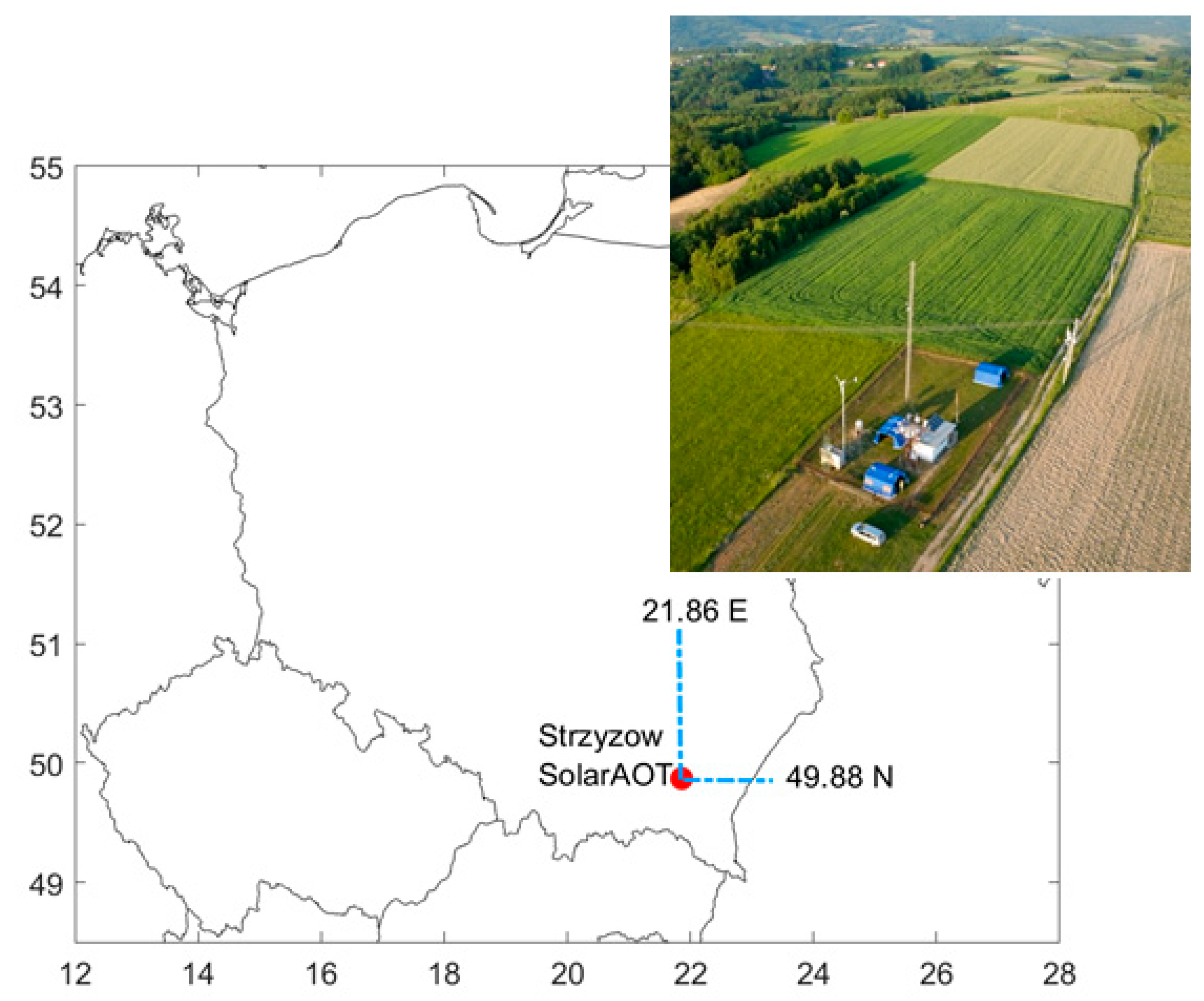
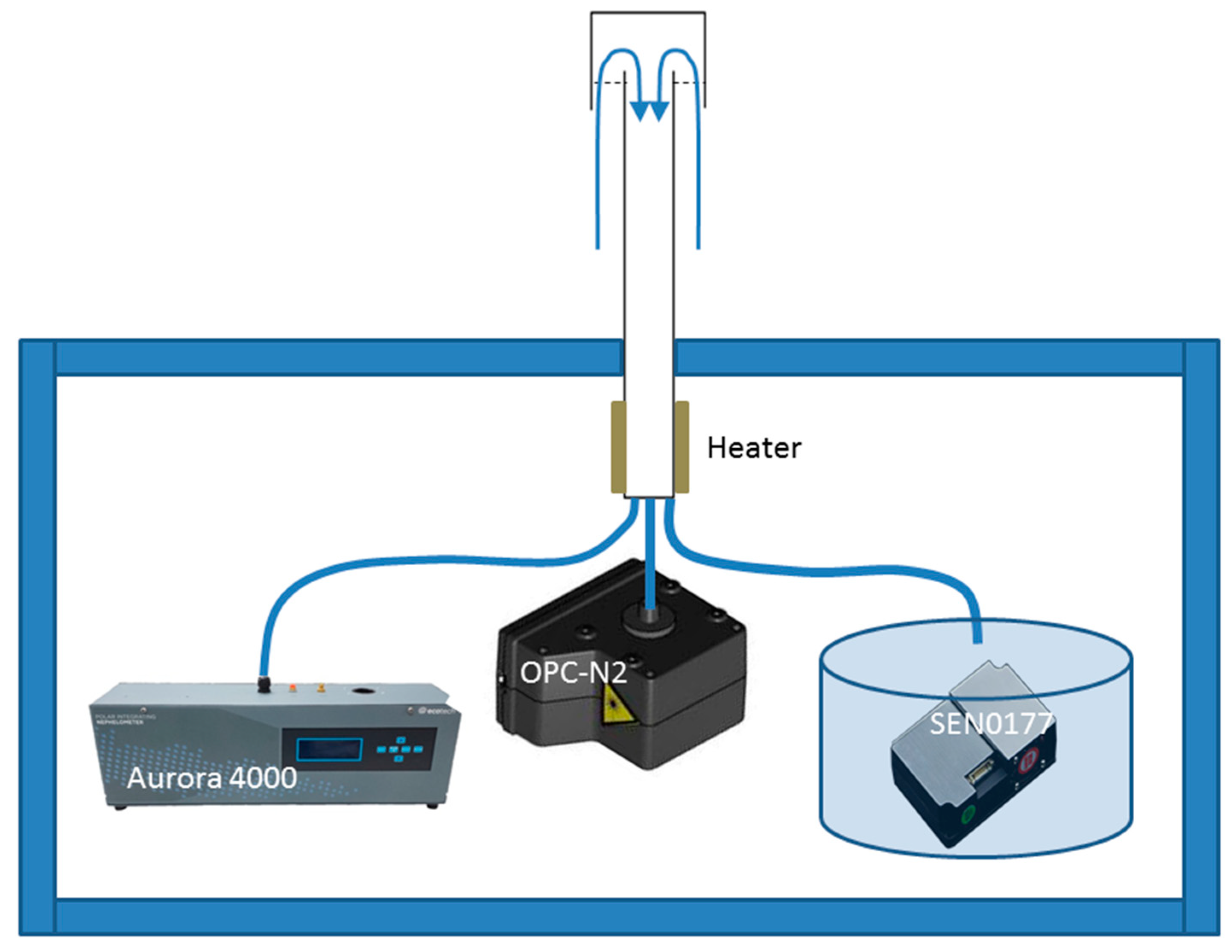
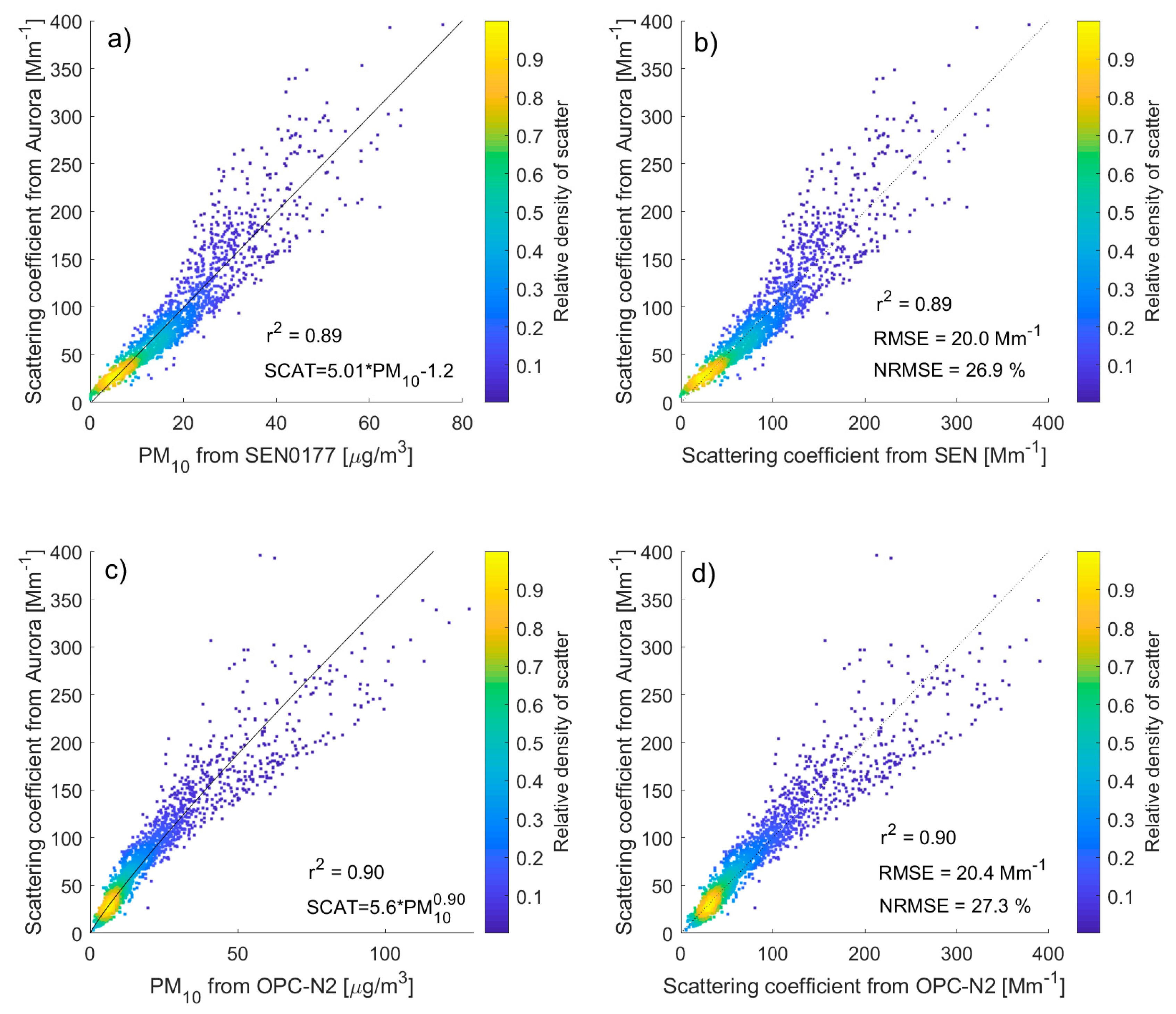

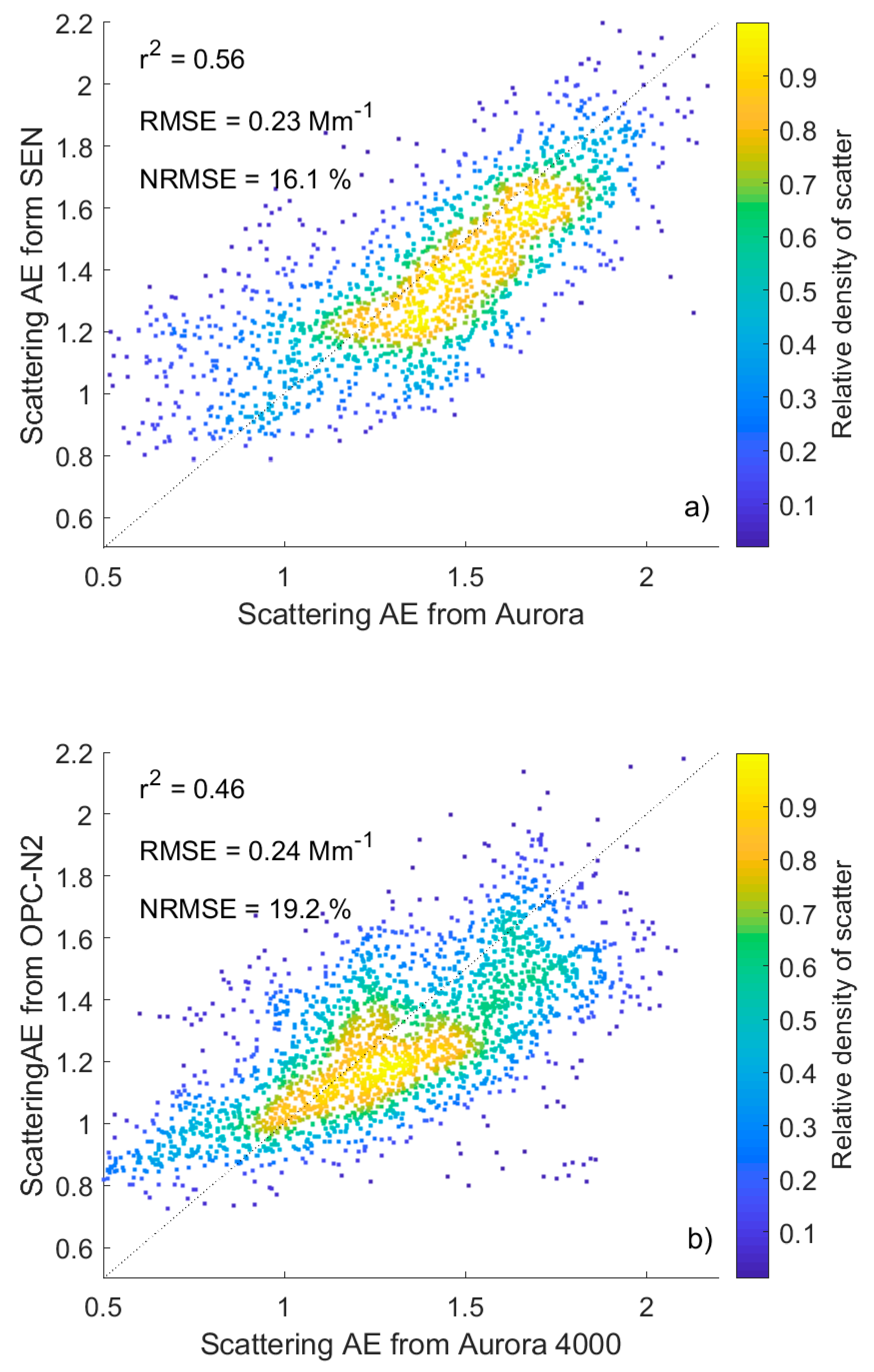
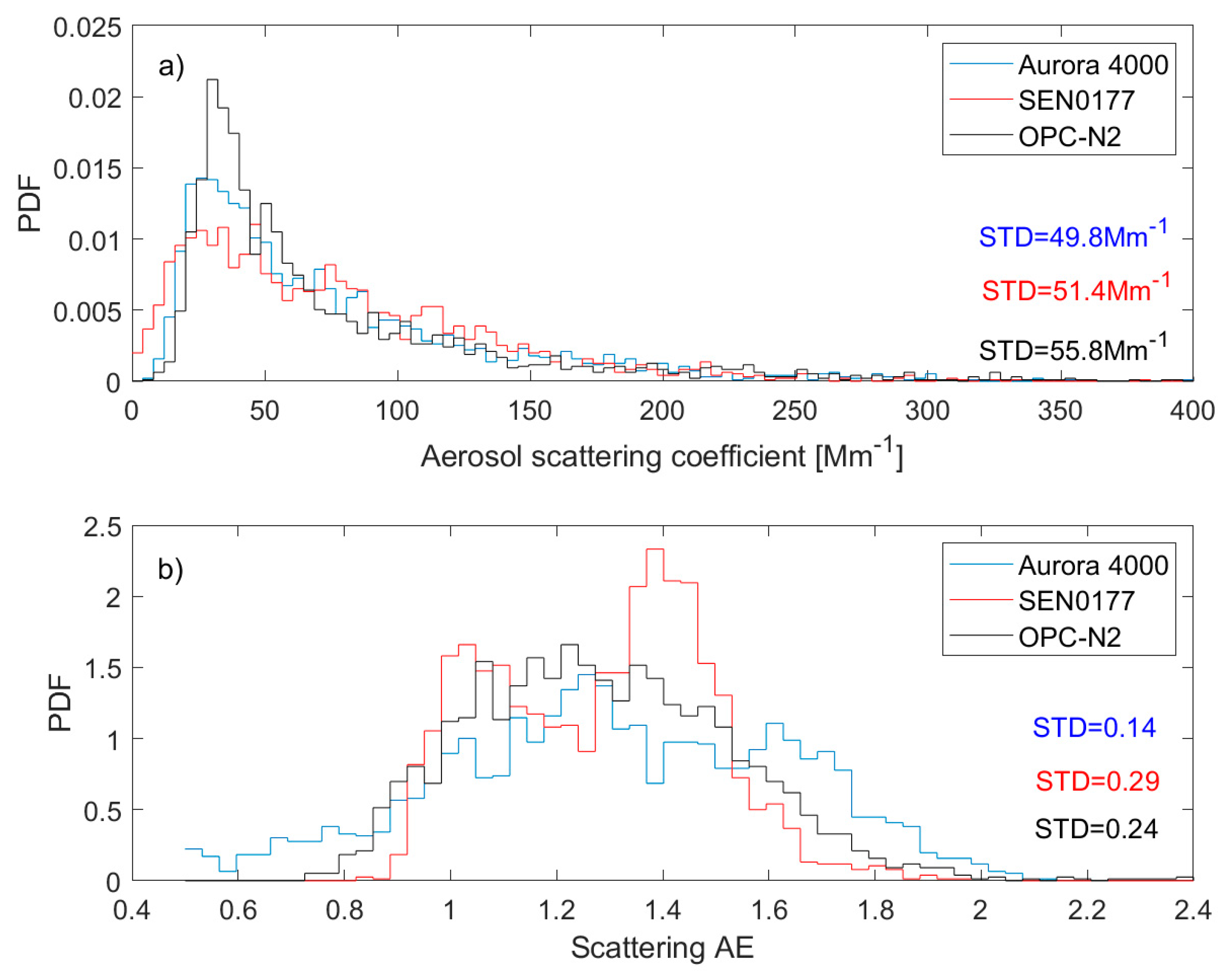



| Aurora 4000 | SEN 0177 | Linear Fit | Log-Log Fit | ||||||
|---|---|---|---|---|---|---|---|---|---|
| r | Slope [Mm−1/µg/m3] | Offset [Mm−1] | RMSE [Mm−1] | r | Slope | Offset | RMSE | ||
| Scattering coefficient at 525 nm | PM1 | 0.91 | 7.71 ± 0.07 | −5.1 ± 0.9 | 25.1 | 0.89 | 0.72 ± 0.01 | 2.56 ± 0.02 | 0.35 |
| PM2.5 | 0.93 | 5.70 ± 0.05 | −2.5 ± 0.8 | 22.1 | 0.92 | 0.77 ± 0.01 | 2.25 ± 0.02 | 0.29 | |
| PM10 | 0.94 | 5.02 ± 0.04 | −1.2 ± 0.5 | 20.0 | 0.95 | 0.82 ± 0.01 | 2.06 ± 0.01 | 0.25 | |
| AE * | N1/N4 | 0.74 | 1.22·10−4 ± 3·10−6 | 0.77 ± 0.02 | 0.23 | 0.75 | 0.50 ± 0.01 | −3.9 ± 0.1 | 0.23 |
| Aurora 4000 | OPC-N2 | Linear Fit | Log-Log Fit | ||||||
|---|---|---|---|---|---|---|---|---|---|
| r | Slope [Mm−1/µg/m3] | Offset [Mm−1] | RMSE [Mm−1] | r | Slope | Offset | RMSE | ||
| Scattering coefficient at 525 nm | PM1 | 0.95 | 3.41 ± 0.02 | 22.5 ± 0.5 | 18.2 | 0.98 | 0.75 ± 0.01 | 2.37 ± 0.01 | 0.17 |
| PM2.5 | 0.94 | 3.00 ± 0.02 | 22.2 ± 0.5 | 19.5 | 0.97 | 0.78 ± 0.01 | 2.15 ± 0.01 | 0.18 | |
| PM10 | 0.94 | 3.10 ± 0.02 | 17.1 ± 0.6 | 20.1 | 0.95 | 0.89 ± 0.01 | 1.72 ± 0.02 | 0.24 | |
| Ntot | 0.96 | 1.42 ± 0.01 | 20.4 ± 0.5 | 16.7 | 0.98 | 0.75 ± 0.01 | 1.66 ± 0.02 | 0.16 | |
| AE * | N1/N2 | 0.66 | 0.064 ± 0.002 | 0.64 ± 0.02 | 0.25 | 0.68 | 0.59 ± 0.01 | −1.12 ± 0.03 | 0.24 |
| Sensor | Bin Ratio/Effective Radius | Bin Radius Range | r | r 95% Interval |
|---|---|---|---|---|
| SEN0177 | N1/N2 | N1: 0.15–0.25 µm N2: 0.25–0.50 µm N3: 0.50–1.25 µm N4: 1.25–2.50 µm N5: 2.50–5.00 µm | −0.60 | −0.61: −0.58 |
| N1/N3 | 0.63 | 0.62: 0.65 | ||
| N1/N4 | 0.74 | 0.73: 0.75 | ||
| N1/N5 | 0.50 | 0.48: 0.51 | ||
| −0.69 | −0.70: −0.68 | |||
| OPC-N2 | N1/N2 | N1: 0.19–0.27 µm N2: 0.27–0.39 µm N3: 0.39–0.52 µm N4: 0.52–0.66 µm N5: 0.66–0.80 µm | 0.66 | 0.63: 0.68 |
| N1/N3 | 0.38 | 0.35: 0.42 | ||
| N1/N4 | 0.03 | 0.00: 0.07 | ||
| N1/N5 | −0.12 | −0.21: 0.17 | ||
| 0.02 | −0.01: 0.07 |
© 2020 by the authors. Licensee MDPI, Basel, Switzerland. This article is an open access article distributed under the terms and conditions of the Creative Commons Attribution (CC BY) license (http://creativecommons.org/licenses/by/4.0/).
Share and Cite
Markowicz, K.M.; Chiliński, M.T. Evaluation of Two Low-Cost Optical Particle Counters for the Measurement of Ambient Aerosol Scattering Coefficient and Ångström Exponent. Sensors 2020, 20, 2617. https://doi.org/10.3390/s20092617
Markowicz KM, Chiliński MT. Evaluation of Two Low-Cost Optical Particle Counters for the Measurement of Ambient Aerosol Scattering Coefficient and Ångström Exponent. Sensors. 2020; 20(9):2617. https://doi.org/10.3390/s20092617
Chicago/Turabian StyleMarkowicz, Krzysztof M., and Michał T. Chiliński. 2020. "Evaluation of Two Low-Cost Optical Particle Counters for the Measurement of Ambient Aerosol Scattering Coefficient and Ångström Exponent" Sensors 20, no. 9: 2617. https://doi.org/10.3390/s20092617
APA StyleMarkowicz, K. M., & Chiliński, M. T. (2020). Evaluation of Two Low-Cost Optical Particle Counters for the Measurement of Ambient Aerosol Scattering Coefficient and Ångström Exponent. Sensors, 20(9), 2617. https://doi.org/10.3390/s20092617





